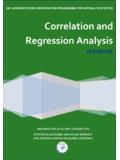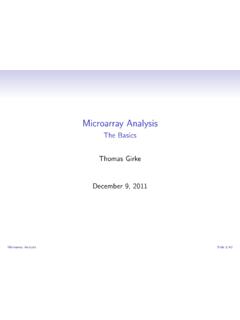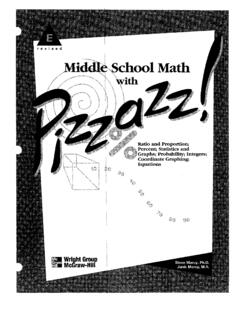Transcription of Correlation and Regression Analysis - OIC-StatCom
1 OIC ACCREDITATION CERTIFICATION PROGRAMME FOR OFFICIAL STATISTICS. Correlation and Regression Analysis TEXTBOOK. ORGANISATION OF ISLAMIC COOPERATION. STATISTICAL ECONOMIC AND SOCIAL RESEARCH. AND TRAINING CENTRE FOR ISLAMIC COUNTRIES. OIC ACCREDITATION CERTIFICATION PROGRAMME FOR OFFICIAL STATISTICS. Correlation and Regression Analysis TEXTBOOK. {{Dr. Mohamed Ahmed Zaid}}. ORGANISATION OF ISLAMIC COOPERATION. STATISTICAL ECONOMIC AND SOCIAL RESEARCH. AND TRAINING CENTRE FOR ISLAMIC COUNTRIES. 2015 The Statistical, Economic and Social Research and Training Centre for Islamic Countries (SESRIC). Kud s Cad. No: 9, Diplomatik Site, 06450 Oran, Ankara Turkey Telephone +90 312 468 6172. Internet E-mail The material presented in this publication is copyrighted.
2 The authors give the permission to view, copy download, and print the material presented that these materials are not going to be reused, on whatsoever condition, for commercial purposes. For permission to reproduce or reprint any part of this publication, please send a request with complete information to the Publication Department of SESRIC. All queries on rights and licenses should be addressed to the Statistics Department, SESRIC, at the aforementioned address. DISCLAIMER: Any views or opinions presented in this document are solely those of the author(s) and do not reflect the views of SESRIC. ISBN: xxx-xxx-xxxx-xx-x Cover design by Publication Department, SESRIC. For additional information, contact Statistics Department, SESRIC.
3 I CONTENTS. Acronyms .. iii Acknowledgement .. iv UNIT 1. Introduction .. 1. Preface .. 1. What Are Correlation and Regression ? .. 1. Assumptions of parametric and non parametric Statistics .. 2. Test of Significance .. 3. UNIT 2. Correlation Analysis .. 4. Definition .. 4. Assumption of Correlation .. 5. Bivariate Correlation .. 5. Partial Correlation .. 7. Correlation Coefficients: Pearson, Kendall, Spearman .. 8. Exercises .. 12. UNIT 3. Regression Analysis .. 13. Definition .. 13. Objectives of Regression Analysis .. 13. Assumption of Regression Analysis .. 14. Simple Regression Model .. 14. Multiple Regressions Model .. 17. Exercises .. 21. UNIT 4. Applied Example using Statistics package .22. Preface .. 22. Bivariate Correlation .
4 24. Partial Correlation .. 26. Linear Regression Model .. 26. Stepwise Analysis Methods .. 28. Exercises .. 30. ii ACRONYMS. Pearson Coefficient of Correlation . Kendall's Tau Coefficient of Correlation . Spearman Coefficient of Correlation R2 Coefficient of Determination Significance Level P_value Calculated Significance value ( probability value). SPSS Statistical Package for Social Science OR Statistical Product for Solutions Services CAPMAS Central Agency of Public Mobilization and Statistics (Statistic office of Egypt). iii ACKNOWLEDGEMENT. Prepared jointly by the Central Agency of Public Mobilization and Statistics (CAPMAS) in Cairo, Egypt and the Statistical, Economic and Social Research and Training Centre for Islamic Countries (SESRIC) under the OIC Accreditation and Certification Programme for Official Statisticians (OIC-CPOS) supported by Islamic Development Bank Group (IDB), this textbook on Correlation and Regression Analysis covers a variety topics of how to investigate the strength , direction and effect of a relationship between variables by collecting measurements and using appropriate statistical Analysis .
5 Also this textbook intends to practice data of labor force survey year 2015, second quarter (April, May, June), in Egypt by identifying how to apply Correlation and Regression statistical data Analysis techniques to investigate the variables affecting phenomenon of employment and unemployment. iv UNIT 1. INTRODUCTION. Preface The goal of statistical data Analysis is to understand a complex, real-world phenomenon from partial and uncertain observations. It is important to make the distinction between the mathematical theory underlying statistical data Analysis , and the decisions made after conducting an Analysis . Where there is a subjective part in the way statistical Analysis yields actual human decisions. Understanding the risk and the uncertainty behind statistical results is critical in the decision-making process.
6 In this textbook, we will study the relation and association between phenomena through the Correlation and Regression statistical data Analysis , covering in particular how to make appropriate decisions throughout applying statistical data Analysis . In regards to technical cooperation and capacity building, this textbook intends to practice data of labor force survey year 2015, second quarter (April, May, June), in Egypt by identifying how to apply Correlation and Regression statistical data Analysis techniques to investigate the variables affecting phenomenon of employment and unemployment. There are many terms that need introduction before we get started with the recipes. These notions allow us to classify statistical techniques within multiple axes.
7 Prediction consists of learning from data, and predicting the outcomes of a random process based on a limited number of observations, the term "predictor" can be misleading if it is interpreted as the ability to predict even beyond the limits of the data. Also, the term "explanatory variable" might give an impression of a causal effect in a situation in which inferences should be limited to identifying associations. The terms "independent" and "dependent" variable are less subject to these interpretations as they do not strongly imply cause and effect Observations are independent realizations of the same random process; each observation is made of one or several variables. Mainly variables are either numbers, or elements belonging to a finite set "finite number of values".
8 The first step in an Analysis is to understand what your observations and variables are. Study is univariate if you have one variable. It is Bivariate if there are two variables and multivariate if at least two variables. Univariate methods are typically simpler. That being said, univariate methods may be used on multivariate data, using one dimension at a time. Although interactions between variables cannot be explored in that case, it is often an interesting first approach. What Are Correlation and Regression Correlation quantifies the degree and direction to which two variables are related. Correlation does not fit a line through the data points. But simply is computing a Correlation coefficient that tells how much one variable tends to change when the other one does.
9 When r is , there is no relationship. When r is positive, there is a trend that one variable goes up as the 1. other one goes up. When r is negative, there is a trend that one variable goes up as the other one goes down. With Correlation , it doesn't have to think about cause and effect. It doesn't matter which of the two variables is call dependent and which is call independent, if the two variables swapped the degree of Correlation coefficient will be the same. The sign (+, -) of the Correlation coefficient indicates the direction of the association. The magnitude of the Correlation coefficient indicates the strength of the association, A. Correlation of r = - suggests a strong, negative association (reverse trend) between two variables, whereas a Correlation of r = suggest a weak, positive association.
10 A Correlation close to zero suggests no linear association between two continuous variables. Linear Regression finds the best line that predicts dependent variable from independent variable. The decision of which variable calls dependent and which calls independent is an important matter in Regression , as it'll get a different best-fit line if you swap the two. The line that best predicts independent variable from dependent variable is not the same as the line that predicts dependent variable from independent variable in spite of both those lines have the same value for R2. Linear Regression quantifies goodness of fit with R2, if the same data put into Correlation matrix the square of r degree from Correlation will equal R2 degree from Regression .



